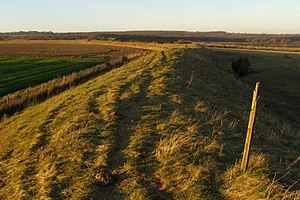Bokerley Dyke: Difference between revisions
Created page with "right|thumb|300px|Bokerley Dyke on Martin Down {{county|Hampshire}} '''Bokerley Dyke''' (or '''Bokerley Ditc..." |
m →top: clean up, replaced: medieval → mediæval |
||
| Line 1: | Line 1: | ||
[[File:Bokerley Dyke, Martin Down - geograph.org.uk - 674000.jpg|right|thumb|300px|Bokerley Dyke on Martin Down]] | [[File:Bokerley Dyke, Martin Down - geograph.org.uk - 674000.jpg|right|thumb|300px|Bokerley Dyke on Martin Down]] | ||
{{county|Hampshire}} | {{county|Hampshire}} | ||
'''Bokerley Dyke''' (or '''Bokerley Ditch''') is a linear earthwork three and a half miles long forming part of the border of [[Dorset]] and [[Wiltshire]], stretching between [[Woodyates]] and [[Martin, Wiltshire|Martin]]. It is a Scheduled Monument.<ref>{{NHLE|1012135|Bokerley Dyke, and a section of Grim's Ditch, a section of a | '''Bokerley Dyke''' (or '''Bokerley Ditch''') is a linear earthwork three and a half miles long forming part of the border of [[Dorset]] and [[Wiltshire]], stretching between [[Woodyates]] and [[Martin, Wiltshire|Martin]]. It is a Scheduled Monument.<ref>{{NHLE|1012135|Bokerley Dyke, and a section of Grim's Ditch, a section of a mediæval boundary bank, and two bowl barrows on and north west of Martin Down|type=monument}}</ref> It is also spelt Bokerly Dyke.<ref name=pr>{{Cite book|last=Pitt-Rivers, Augustus Henry Lane-Fox, 1827-1900.|url=http://worldcat.org/oclc/863389459|title=Excavations in Cranborne Chase, near Rushmore, on the borders of Dorset and Wilts.|date=1887-1905|publisher=[Harrison and Sons, Printers] Printed privately|oclc=863389459}}</ref> | ||
Bokerley Dyke was excavated by Augustus Pitt Rivers between 1888 and 1891<ref name=pr /> and by Philip Rahtz<ref>{{Cite journal|last=Rahtz|first=Philip A.|date=January 1961|title=An Excavation on Bokerly Dyke, 1958|url=http://dx.doi.org/10.1080/00665983.1961.10854188|journal=Archaeological Journal|volume=118|issue=1|pages=65–99|doi=10.1080/00665983.1961.10854188|issn=0066-5983}}</ref> in advance of road widening in 1958. Bokerley Dyke may have originated in the Bronze Age or Early Iron Age and formed a political and cultural boundary.<ref name=ps>{{pastscape|906268|Bokerley Dyke}}</ref> It was cut through by a Roman Road ([[Ackling Dyke]] running between [[Old Sarum]] and [[Badbury Rings]]) in the 1st century.<ref name=ps/> | Bokerley Dyke was excavated by Augustus Pitt Rivers between 1888 and 1891<ref name=pr /> and by Philip Rahtz<ref>{{Cite journal|last=Rahtz|first=Philip A.|date=January 1961|title=An Excavation on Bokerly Dyke, 1958|url=http://dx.doi.org/10.1080/00665983.1961.10854188|journal=Archaeological Journal|volume=118|issue=1|pages=65–99|doi=10.1080/00665983.1961.10854188|issn=0066-5983}}</ref> in advance of road widening in 1958. Bokerley Dyke may have originated in the Bronze Age or Early Iron Age and formed a political and cultural boundary.<ref name=ps>{{pastscape|906268|Bokerley Dyke}}</ref> It was cut through by a Roman Road ([[Ackling Dyke]] running between [[Old Sarum]] and [[Badbury Rings]]) in the 1st century.<ref name=ps/> | ||
Latest revision as of 12:35, 30 January 2021

Bokerley Dyke (or Bokerley Ditch) is a linear earthwork three and a half miles long forming part of the border of Dorset and Wiltshire, stretching between Woodyates and Martin. It is a Scheduled Monument.[1] It is also spelt Bokerly Dyke.[2]
Bokerley Dyke was excavated by Augustus Pitt Rivers between 1888 and 1891[2] and by Philip Rahtz[3] in advance of road widening in 1958. Bokerley Dyke may have originated in the Bronze Age or Early Iron Age and formed a political and cultural boundary.[4] It was cut through by a Roman Road (Ackling Dyke running between Old Sarum and Badbury Rings) in the 1st century.[4]
In the 4th century the dyke was remodelled and brought back into use, and excavations show that the Roman road was blocked.[4][5]
A coin of Valens dates this activity to shortly after 364 AD.[4] It may have been built in 367-8 AD when Roman sources report that Britain was attacked by Picts, Scots and Saxons in a supposed 'Great Conspiracy'.[5] The Roman road was later reopened, but the dyke may have continued in use after the cessation of the Roman rule and still forms part of a boundary between the counties of Dorset and Wiltshire.[4]
Bokerley Dyke runs through Martin and Tidpit Downs, which is a Site of Special Scientific Interest, and it is continuous with Grim's Ditch.
Outside links
| ("Wikimedia Commons" has material about Bokerley Dyke) |
- Location map: 50°58’20"N, 1°56’30"W
References
- ↑ National Heritage List 1012135: Bokerley Dyke, and a section of Grim's Ditch, a section of a mediæval boundary bank, and two bowl barrows on and north west of Martin Down (Scheduled ancient monument entry)
- ↑ 2.0 2.1 Pitt-Rivers, Augustus Henry Lane-Fox, 1827-1900. (1887-1905). Excavations in Cranborne Chase, near Rushmore, on the borders of Dorset and Wilts.. [Harrison and Sons, Printers] Printed privately. OCLC 863389459. http://worldcat.org/oclc/863389459.
- ↑ Rahtz, Philip A. (January 1961). "An Excavation on Bokerly Dyke, 1958". Archaeological Journal 118 (1): 65–99. doi:10.1080/00665983.1961.10854188. SSN 0066-5983. http://dx.doi.org/10.1080/00665983.1961.10854188.
- ↑ 4.0 4.1 4.2 4.3 4.4 National Monuments Record: No. 906268 – Bokerley Dyke
- ↑ 5.0 5.1 Bill Putnam, (2000), Discover Dorset: The Romans, page 71. The Dovecote Press
